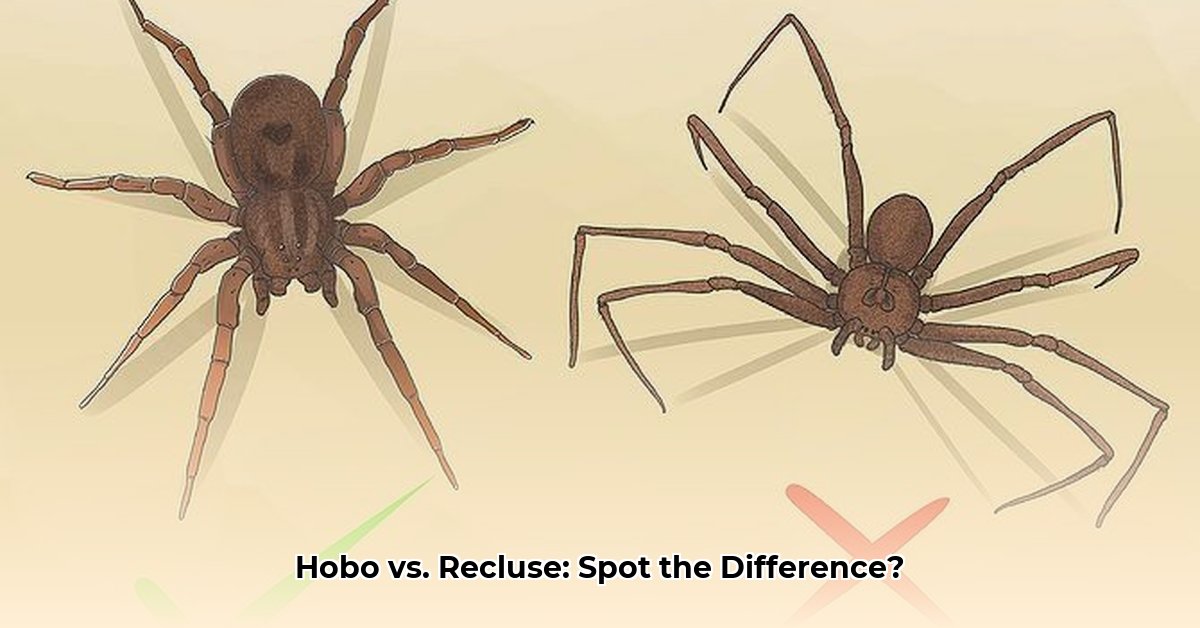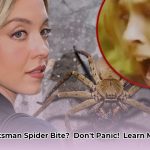Worried about spiders in your home? This comprehensive guide will help you distinguish between hobo spiders and brown recluse spiders. Learn about identification, bite risks, prevention strategies, and what to do if you suspect a bite.
Hobo Spider vs Brown Recluse: Understanding the Key Differences
Identifying hobo spiders and brown recluses accurately is crucial for managing risks and ensuring appropriate responses. These spiders are often confused due to their similar brown coloration, but distinct characteristics can help differentiate them. This guide clarifies identification, bite risks, and preventive measures to reduce anxiety and promote safety.
Geographic Location as a Primary Identifier
Geographic location is a vital clue when identifying spiders. Hobo spiders are commonly found in the Pacific Northwest region of the United States, including Washington, Oregon, Idaho, and parts of western Canada. Brown recluse spiders, on the other hand, prefer warmer climates and are prevalent in the central and southern United States, particularly in states like Missouri, Arkansas, Kansas, Oklahoma, and Texas. Finding a brown recluse in Oregon or a hobo spider in Texas would be highly unusual. This geographic segregation is a helpful starting point for identification and minimizing potential misidentification.
Detailed Spider Identification: Focusing on Distinct Physical Features
While size can vary, relying on specific physical features is essential for accurate identification. Here’s a detailed comparison table to enhance your spider identification skills:
| Feature | Hobo Spider | Brown Recluse Spider |
|---|---|---|
| Eyes | Eight eyes arranged in two rows of four. | Six eyes arranged in three pairs, forming a semi-circular pattern. |
| Markings | Brown with chevron-shaped patterns on the abdomen; the pattern may be faint or indistinct. | A distinctive dark brown, violin-shaped marking on the cephalothorax (the body part to which the legs attach), with the “neck” of the violin pointing towards the abdomen. |
| Body Shape | Stocky build, not particularly flattened, legs are moderately long. | Flattened body with legs that are noticeably longer in proportion to the body. |
| Web Style | Builds a funnel-shaped web, often found in corners, crevices, and around objects at ground level. | Creates an irregular, sticky web, often in sheltered and dark locations like closets and boxes. |
| Typical Habitat | Commonly found outdoors under rocks, woodpiles, and in undisturbed areas. | Prefers indoor environments, dark corners, closets, attics, and undisturbed areas. |
| Leg Markings | Legs are uniformly colored. | Legs are uniformly colored, lacking bands or distinct markings. |
| Size | Body length typically ranges from 0.3 to 0.6 inches. | Body length typically ranges from 0.25 to 0.5 inches. |
Use reliable online resources with high-resolution images and detailed descriptions to compare these features for more accurate identification. Pay close attention to the eye arrangement and markings, as these are the most definitive characteristics.
Understanding the Bite: Potential Reactions and Risks
Brown recluse bites are known for their potential to cause necrotic lesions (tissue death) and may require medical intervention. The venom contains enzymes that can break down tissue, leading to a slow-healing wound. Hobo spider bites are generally considered less severe, causing pain, swelling, and redness, similar to a bee sting. Initial beliefs about hobo spider venom causing necrosis have been largely discredited by modern research. However, individual reactions can vary, and ongoing research aims to fully understand the effects of hobo spider venom. Given the uncertainties and potential for secondary infection, seeking medical attention is always recommended if bitten by either spider.
A Step-by-Step Guide to Identifying Spiders Safely
To identify a spider safely and accurately, follow these steps:
- Observe the Location: Note the geographic location where you encountered the spider, as this can help narrow down the possibilities. Take note of the spider’s microhabitat as well such as in a wood pile or closet.
- Visual Examination: Carefully observe the spider’s physical characteristics, including eye arrangement, markings, body shape, size, and web type. If possible, use a magnifying glass or take clear photographs.
- Safe Collection (Optional): If you feel comfortable and safe doing so, carefully collect the spider in a clear, sealed container without harming it. This allows for more precise identification by a professional.
- Comparative Analysis: Use the table above and consult reliable online resources, such as university extension websites and entomology guides, to compare your observations with known characteristics of hobo spiders and brown recluse spiders.
- Professional Consultation: If you are unsure about the identification or have been bitten, seek professional advice from a pest control expert or medical professional.
- Medical Attention (If Bitten): Get medical advice immediately if bitten by a spider, especially if symptoms are severe or worsening. Bring the spider (if safely collected) or a clear photo to aid in identification and guide treatment.
Prevention and Control: Reducing Spider Populations Around Your Home
Preventing spider problems involves a multi-faceted approach:
- Maintain Cleanliness: Regularly clean your home, focusing on corners, crevices, under furniture, and cluttered areas where spiders like to hide. Vacuum regularly to remove webs, egg sacs, and spiders.
- Seal Entry Points: Seal any gaps and cracks in walls, windows, and foundations to prevent spiders from entering your home. Use caulk or weather stripping to close openings.
- Reduce Clutter: Remove excess clutter, especially in areas like basements, attics, and garages, to eliminate spider hiding places. Store items in sealed plastic containers.
- Control Insect Populations: Spiders feed on insects, so controlling insect populations around your home can reduce the spider population. Use insect light traps, remove standing water, and practice good sanitation.
- Outdoor Maintenance: Keep vegetation trimmed away from the house, as spiders can use plants to climb onto your home. Remove woodpiles, debris, and other potential spider habitats from your yard.
- Use Natural Repellents: Some people have success using natural repellents like peppermint oil, tea tree oil, or eucalyptus oil to deter spiders. Dilute the oil with water and spray around entry points and known spider habitats.
- Professional Pest Control: For significant or persistent spider problems, contact a licensed pest control professional. They can identify the spider species and implement a targeted treatment plan.
Accurate identification is crucial for appropriate treatment and effective prevention strategies. Always use credible sources of information, such as university extension websites, entomology guides, and medical professionals. This information is for general guidance only and should not replace professional medical advice or pest control services.
Differentiating Hobo Spider Bites from Brown Recluse Bites: A Detailed Comparison
Key Takeaways:
- Geographic location provides the first clue in distinguishing hobo spider bites from brown recluse bites. Hobo spiders are primarily found in the Pacific Northwest, while brown recluses inhabit central and southern U.S. states.
- Distinctive physical characteristics set these spiders apart – eye arrangement, body markings, and overall size.
- Although both spiders can bite, the severity and nature of their bites differ significantly. Hobo spider bites generally cause mild, localized symptoms, while brown recluse bites can lead to severe tissue damage and systemic effects.
- Prevention strategies focus on eliminating spider habitats and limiting their access to living spaces.
Geographic Distribution: A Crucial First Step
Knowing your location is the first step in distinguishing hobo spider bites from brown recluse bites. Hobo spiders prefer the Pacific Northwest, while brown recluses stick to the central and southern U.S. This geographic distinction helps narrow down the possibilities when assessing a potential spider bite.
Identifying Spiders by Appearance: Identifying Features to Look For
Hobo spiders have eight eyes, arranged in two rows of four, and chevron patterns on their abdomens. Brown recluses have six eyes in three pairs and a violin-shaped marking on their backs. Familiarize yourself with these key differences to aid in identification.
Venom and Bite Symptoms: A Clear Distinction
Initial concerns about hobo spider venom causing necrotic lesions (tissue death) have been largely discredited. Hobo spider bites cause mainly local pain, redness, and swelling that typically clears up within a couple of weeks. Brown recluse venom is necrotoxic (tissue destroying). Brown recluse bites can progress to blisters, ulcers, and significant tissue damage over several days. Systemic symptoms, such as fever and nausea, are also possible with brown recluse bites.
A Step-by-Step Guide to Bite Identification and First Aid
- Consider Location: Where did the bite occur? If you are in the Pacific Northwest, a hobo spider bite is more likely. If you are in the central or southern U.S., a brown recluse bite is more likely.
- Examine the Spider (if possible): If you saw the spider, try to collect it safely or take a clear photograph. Use a magnifying glass to examine eyes and body markings. Note the size, color, and any distinctive patterns.
- Compare to Reference Images: Use reputable resources, such as the Centers for Disease Control and Prevention (CDC) or university extension websites, to compare your observations with known characteristics of hobo spiders and brown recl
- Unlock Young Doctors’ Work-Life Balance: Actionable Strategies Now - December 2, 2025
- Unlock Life Harmony: Work-Life Integration Guide - November 30, 2025
- Unlock Work-Life Harmony:Your Guide to Integration - November 27, 2025
















